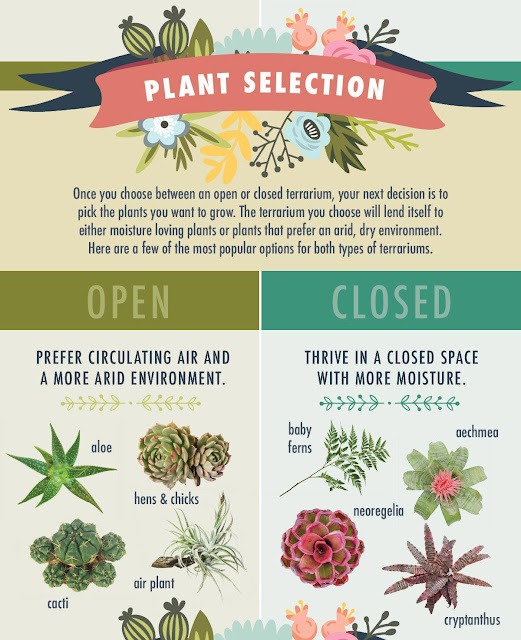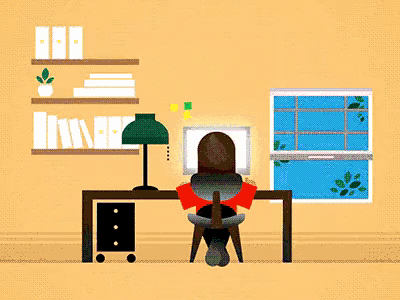Terrariums : Your Personalised Naturescapes.
“Everything that slows us down and forces patience, everything that sets us back into the slow circles of nature is a help. Creating Terrariums is one such instrument of grace.”
Do you have love for nature or gardening, but lack the space? Do you love plants, but don’t have patience to maintain them? Do you want to insert a bit of green into your homes or office spaces or simply wish to put smile on your friends face with a “living gift”?
If the answer to any of the above is an enthusiastic “yes”,
then all you need is a homemade terrarium for yourself. These small sized mini
ecosystems have a big impact on us & our surroundings.
Nowadays it is observed that people are having growing
interests in Biophilic living and looking for the connect with nature. Let’s
explore how these mini-ecosystems of terrariums could benefit us more…
What are Terrariums?
Terrarium are self-contained miniature green pockets created inside a clear enclosure (limited to a confined space) with no drainage hole that mimics an ecosystem by creating additional humidity through its own water cycle. Terrariums bring a touch of nature, enliven the indoor space and add greenery inside homes and offices. They are also known as gardens under glass.
Known for their low maintenance requirements, terrariums work well for people with busy lives or those that struggle to keep plants alive due to lack of care.Terrariums allow maintaining plants all year long by
adding or eliminating them as per
choice & requirements. Being container based, terrariums are limited to the amount of space you give
them, never intruding into areas not intended for them.
The best part is that they don’t require water often and are great alternative to grow plants in low or no-light environments.
What do you need to
build a Terrarium?
Terrariums require a
container that will house the green plants. It can be made with empty jam
jars, old fish bowl, old glass vase or bulky glass bottles etc.
The “terra” (earth/growing medium) part of the terrarium depends on the type of plants you want to grow, and can range from collected rocks, pebbles and sand to potting soil or compost.
Activated charcoal
helps to keep the terrarium clean. Shells, small trinkets, old toys and up
cycled waste materials can be added as decorative
touches.
Terrariums can be made using your own hands with pair of gloves and some garden tools along with
some patience.
What plants will you
grow in your terrarium?
The plant you choose
should be able to thrive in the ecosystem you create, they shouldn’t grow
too large for the container, and that there are
limits to root growth. Your local gardening shops or florist should be able
to provide advice on suitable plants.
Following plants are most preferred for terrariums:
- Pilea involucrata (Friendship plants)
- Variegated spider ferns
- Watermelon peperomia plant
- Fittonia (Silver nerve plant)
- Spiderwort plant
- Air plant
- African violets
- Dracena borgata plant
- Hedra helix plant
- Pothos plant
- Pentas plant
- Spathiphyllum plant
- Chlorophytum plant
- Jade plant
- Syngonium plant
How to build your
terrarium?
Once you have all your materials and chosen your plants, start
filling your container in layers.
First, create a drainage layer.
Depending on the size of your container, the plants you have chosen and the
type of terrarium you are creating, the thickness will vary, but you definitely
want at least a thin layer of rocks,
stones and pebbles where excess water can go to prevent drowning the roots.
The activated charcoal goes on top, followed by soil.
How to plant your
terrarium?
Making a terrarium is a fun-filled & an engaging activity,
let’s explore more…
Setting plants in clusters with varying heights & sizes,
colour combinations or textural qualities.
Leave in-between spaces well in advance to add decorative
elements/accessories as a finishing touch. Accessories to make terrarium unique
- Sea shells, rocks, ornaments, toys,
trinkets, dried materials, and branches are all great things to add personality.
(Note: Be very careful with the tiny plants and plant them with soft hands into the soil.)
Try to create a real landscape by adding some green moss strips (काई in Hindi) often seen on wet walls or ground.
Make sure you don’t add too many elements into terrariums & make pleasing composition which offers variety and makes the eye to travel upon.
BENEFITS OF TERRARIUMS:
With increasing
awareness about environment consciousness,
back-to-earth or back to nature products
like terrariums are increasingly preferred as gift items for weddings and corporate events.
Mostly
preferred by people living in cities, terrariums is a good way to bring
the beauty of nature into our home & develop the bond with nature back
again.
People
engaged with terrariums as part of their hobby or any other endeavour, helps
them in both psychology and personal development.
Terrariums with variety of plants in indoor spaces could help in regulating the feelings of anger, tension, anxiety and depression. They can also help speed up the recovery & help promote healing of sick people. Many research studies have proven that plants have many therapeutic qualities which help to shift brain into more relaxed state of mind, thereby increasing productivity & scope for creativity to enhance.
Terrariums can act as a helpful learning tool for children and adults alike. These miniature ecosystems help to put science up close and personal for an audience, allowing them to closely observe how plants grow and how the water cycle operates through the system.
Making &
taking care of terrariums as the act of engaging & nurturing
something, enhances the feelings of compassion along with offering visual
calming effect as well.
CARE TO BE TAKEN FOR
TERRARIUMS
However, they do require occasional maintenance and to maintain a healthy environment for your plants, you should avoid making the following mistakes:
Too Much Light
Due to the use of glass container for terrariums, it is
advisable to keep it out of reach of direct sun as it may cause glass to
magnify the light & heat from sun & cause loss of moisture for the plants. Also most plants can't tolerate
this kind of heat & can cause death of tiny plants.
Too Little Light
Grow lights or
fluorescent lights can provide supplemental light or by placing the
terrarium closer to a window that receives well, but indirect light to keep
plants surviving.
Overgrown Plants
Overgrown plants could spoil
the aesthetic look of individual decorative elements inside the terrarium. Timely trimming of overgrown plants is
advisable to prevent from overcrowding.
Pruning the roots of these plants, may also help to keep them small.
Failure to Remove
Dying Plants
As a part of maintenance, all the dead/diseased plants
should be removed out immediately as it may infect other plants inside
terrariums. Replace the plant with one of a similar size and the same moisture
and light requirements. Be sure to surround the roots with soil, leaving no air
pockets.
Dirty Glass
Every once in a while, clean the glass of the terrarium both
inside and out. If the glass is too dirty or foggy, it could be difficult for
light to reach the plants.
Over Watering
Looking at the scale
of the ecosystem of plants, watering should be done very wisely. One way to
prevent over-watering is to use a spray
bottle instead of a watering directly. Remember, the terrariums doesn’t have weep hole/drainage hole like normal
planting pots to remove extra water away. Add small splashes of water rather than flooding the entire terrarium
in such condition.
Over Fertilizing
Since the plants used in terrarium are small & are to be
inhibited to grow large in confined space, most terrarium plants do not need to
be fertilized.
Choosing the Wrong
Plants
Plants which can thrive in confined spaces/closed terrariums
needs to be chosen wisely. Plants which prefer moist environments, low lights
& low heat are most preferred.
The demand for Terrariums increases during Diwali due to higher pollution levels, so what are you waiting for…create your own terrariums, buy them or gift them as ideal gifting options to state We Care.






















I have seen one terrarium but didn't knew how to make one and what all things are necessary for maintaining a terrarium. This surely has cleared my doubts regarding it. I will surely try to build one for myself in future.
ReplyDeleteVery useful and informative blog...
ReplyDeleteNice read...
The concept of terrarium ...its importance and the bonding which it creates towards nature ....its aesthetical approach towards the interiors of an particular space and its maintenance, impact on a human mind...all of this was quite informative and this can create an amazing awareness among the people about the green pockets . Very nice blog sir👍🏼
ReplyDeleteThe blog is informative and encouraging.Terrarium,a new term and concept for me but this blog helped me understand it in detail
ReplyDeleteGood one !!
ReplyDeleteA comprehensive and lucid description of creating one of the most relaxing milieu in today's stressed times. Keep up the good work and spread the green cheer sujit.
ReplyDeleteMadhura kotnis
Beautiful concept
ReplyDeleteVery relaxing n soothing
Keep up the good work👍
New concept and term explained in very detailed manner with ease.....such a nice blog sir !!!
ReplyDeleteVery Useful and Creative!! I liked Garden Under Thr Glass Concept😍! Thank you for sharing this information sir!
ReplyDeleteVery informative written piece.Thankyou for sharing .
ReplyDeleteVery well written, user friendly and perfect do it yourself guide
ReplyDeleteHey Sujit its very informative and the graphics you added gives more clear understanding of the Terrarium - Gardens under glass. Thanks for sharing your knowledge.
ReplyDeleteSuch a beautiful step-by-step walk through for anyone to take up "Terrariums" !! Great summary, Sujith !!...Thanks
ReplyDeleteIt is really an good idea to collection of this plant and vegetation which really give life to the space..
ReplyDeleteThank u sir for this wonderful idea n it's explanation
Very informative. Thank you for sharing with us. Very useful
ReplyDeleteVery useful and informative blog !! Amazing read.
ReplyDeleteThankyou for sharing ..
Such a beautiful concept. A Terrarium is a new concept and term for many, but explained very well. Very informative and encouraging blog. Good job Sujit!!!
ReplyDeleteVery informative!
ReplyDeleteA very new approch for healthy environment, we should encourage its use and application...a must read blog, thank you sir , for summarizing it in such a crisp way.
ReplyDeleteA very informative blog on how we can incorporate terrariums efficiently in indoor spaces.
ReplyDeleteThank you for this informative blog!
ReplyDeleteIt's an amazing concept! Thank you so much sir for enlightening us with this new concept of having plants.
ReplyDeleteThanks for such a good informative blog
ReplyDeleteNice post Air Plant Tillandsia Harrisii
ReplyDeleteNice post Closed Terrarium Daze Plants Dubai
ReplyDeleteNice post Closed Terrarium Plants Dubai
ReplyDeleteNice post Terrarium Dreams Plants Dubai
ReplyDeleteNice post Terrarium UAE
ReplyDeleteNice post Terrarium Dubai
ReplyDeleteNice blog Terrarium Plants in Dubai
ReplyDeleteNice blog Terrarium Plants UAE
ReplyDelete